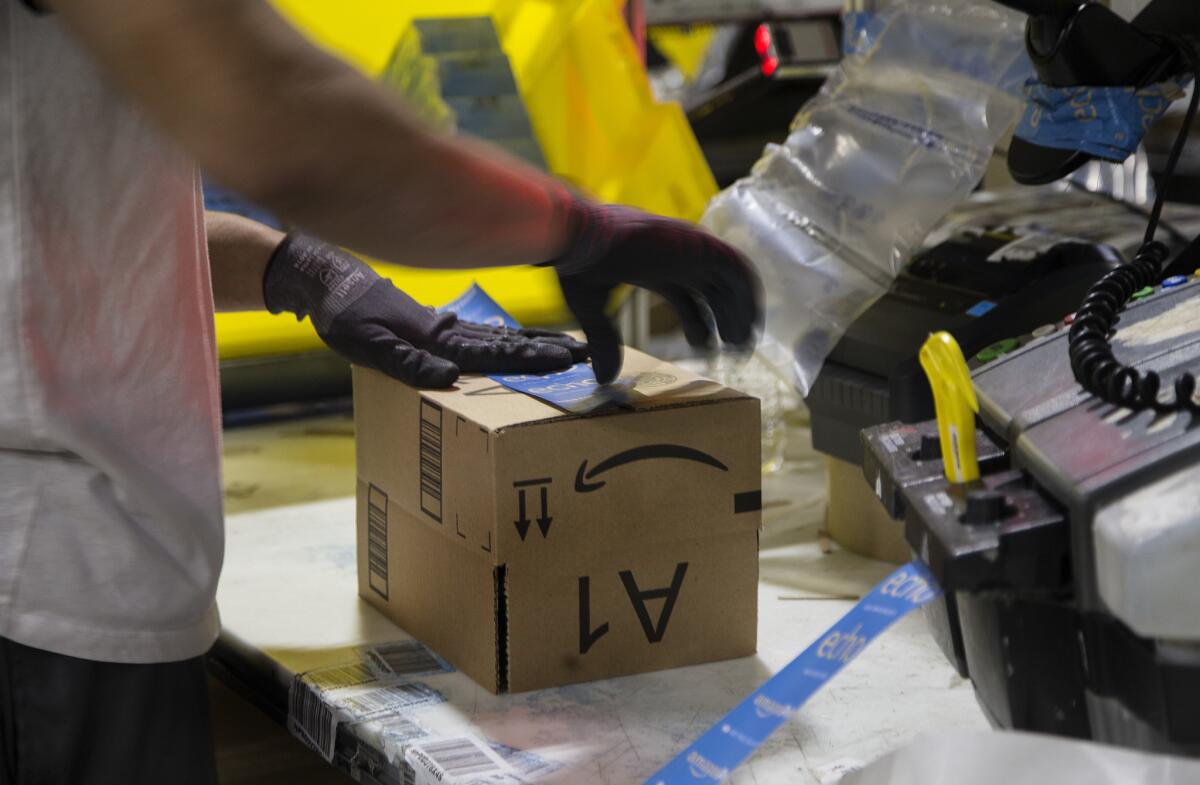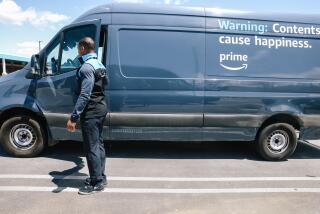Amazon drivers say they are pushed to the limit as holiday deliveries reach a frenzy

There are few things more important to Amazon than delivery. A large part of the reason the retailer is valued at $360 billion is that it has managed to get customers the things they want, cheaper and faster than its competitors.
Someday, the company promises, drones will deposit boxes at people’s doorsteps. But for now, the job of handling the holiday delivery crunch is left to an army of people like Angel Echeverria.
Echeverria, 38, drives for LMS Transportation, a local courier in Inglewood that delivers packages for Amazon. He starts each day with about 260 boxes, which he has to drop off at maybe 200 addresses across up to 80 miles in Southern California.
Factoring in the time needed to load and gas up his white van, which sometimes sports a magnetized Amazon logo on the back door, Echeverria has to hit one home every two minutes, on average. Failing to deliver even one package is not an option, he says.
“If you bring anything back, they basically want to cut your throat off,” says Echeverria, a single father of three who makes $15 an hour.
For all the control it exercises, Amazon doesn’t count Echeverria and many other people who speed around major cities in vans filled with Amazon boxes as its employees.
In an echo of complaints by Uber drivers and other contract workers, delivery drivers in interviews with The Times and in court documents say Amazon is working them past a reasonable point, and often avoids paying them overtime or giving legally required meal breaks.
An Amazon spokeswoman said the company’s code of conduct for contract delivery companies requires them to provide “appropriate work hours and overtime pay.”
But in the last two years, drivers in four states have sued the company for allegedly misclassifying them as independent contractors. Those drivers have said they don’t get overtime pay and can earn less than the minimum wage because they spend so much on gas every week.
In 2015, drivers for Pasadena-based courier Scoobeez who delivered packages for Amazon sued both companies for denying them overtime and effectively paying them less than the minimum wage after drivers subtracted gas, tolls and maintenance from their paychecks.
Drivers in Arizona settled in October with Amazon, which did not admit fault. Cases against the company in California, Illinois and Washington are still being adjudicated.
Labor experts say the cases against Amazon are unusual among contract-work complaints for the level of control the company is claimed to have over the people who deliver its goods.
“With Uber, the individual worker decides on their own when they want to work, how long they want to work, and how they want to provide service to the customer,” said Seth Harris, former deputy secretary of the U.S. Labor Department.
“This is not that. Amazon has a product in its fulfillment center or its warehouse that has to get to a particular person by a particular time, and they are dictating all of that.”
Amazon spokeswoman Kelly Cheeseman said the delivery firms it contracts with make their own decisions about when to fire employees. But she added that Amazon expects the contract companies to provide a certain level of service.
Those expectations mount during the holidays. On its busiest day, the Monday after Thanksgiving — Cyber Monday, in industry parlance — Amazon was expecting to receive more than 54 million orders.
To get the flood of holiday goods to their purchasers, Amazon relies on every delivery option available. That includes FedEx, UPS and the Postal Service, which in 2013 agreed to deliver packages on Sunday for the company.
But three years ago Amazon began relying more on local couriers, said Rob Howard, the chief executive of Grand Junction, a Web platform that connects those companies to Amazon and other e-commerce retailers.
“[Amazon] realized that the local couriers could do more than UPS and FedEx. In many cases they are less expensive, because they are non-unionized, the drivers are independent contractors,” Howard said.
Several drivers and industry officials said in interviews that Amazon keeps records on the performance of every one of its drivers, and pressures contractors to fire the ones who can’t keep up.
In a court deposition, a former manager at a delivery service called LaserShip, which was sued in Virginia by drivers for misclassification, said the company kept those records on drivers on behalf of Amazon. It said the retailer does not want drivers to exceed a certain threshold of complaints, and had requested that the company fire at least one driver.
Echeverria, the Los Angeles driver, reports to work at an Amazon facility in Commerce, where he loads a van up with boxes and then drives to a nearby gas station to fill his tank. Amazon gives him an Android phone with an app that scans packages and determines his route. He says it is also used to track how much of a dent he’s made in his delivery load that day.
He has learned not to stop for lunch because, he said, Amazon employees will call his dispatcher at any point in the day if they notice that he’s behind schedule.
Echeverria said he eats on the road, usually scarfing down hot dogs and chips from 7-Eleven stores, which have Amazon lockers that he often uses for deliveries. California law requires that businesses give 30-minute lunch breaks and regular rest breaks to hourly workers who spend more than five hours on the job.
If a customer calls Amazon to complain about not receiving a package that he was responsible for, Echeverria says he gets cited by the retailer.
On Monday or Tuesday mornings, Echeverria says, his dispatcher at Inglewood-based LMS Transportation gathers drivers together and reads aloud the number of complaints each had the week before, from a weekly report provided by Amazon.
“To put it out in front of everybody, you are being humiliated,” Echeverria said.
Raymond Rakshani, a co-owner of LMS, said Amazon does provide a weekly report on complaints about each driver and measures each driver in terms of “defects per million opportunities,” a metric traditionally used in manufacturing to keep tabs on each worker’s performance.
Rakshani said Amazon does not want any individual driver to exceed a ratio of two complaints for every 1,000 packages they’re tasked with delivering. But he said that Amazon does not instruct LMS to fire drivers who have had a trend of high complaints. LMS independently starts a disciplinary process, he said, starting with retraining, if a driver has a high number of citations for two consecutive weeks.
He disputed other details of the workday described by Echeverria. It’s the LMS dispatcher’s decision, not Amazon’s, to call a driver in the middle of the day if he or she is behind on deliveries, Rakshani said; the dispatcher will communicate the tardiness to Amazon employees, not the other way around.
Rakshani disputed that dispatchers read complaints for each driver aloud. “If it happens, it’s wrong,” he said, adding that he tells managers to talk to drivers one-on-one.
At the start of each day drivers are told by their managers that California law requires them to take 30-minute lunch breaks, he said, and at the end of each day they sign a statement acknowledging that they took lunch.
He also questioned the idea that drivers would be admonished for failing to deliver their entire loads. “I don’t know why he should be scolded,” Rakshani said.
Meticulously tracking drivers, hour by hour, is part of Amazon’s broader obsession with speed, which has allowed it to turn week-long delivery times into days, and now hours.
“They measure the heck out of them to make sure the delivery experience works well,” Howard said.
The company tracks how many missed, damaged or late deliveries each driver at each company has, said Howard, who, before founding Grand Junction, was the CEO of an Oakland-based logistics company that delivered packages for Amazon.
The company encourages couriers to fire drivers who have too many bad marks on their record, and terminates contracts with companies that have too many under-performing drivers, Howard said.
But maintaining a tight grip on drivers may become legally risky for the company, said labor experts and plaintiffs lawyers.
In 2015, the company started a service called Amazon Flex, which allows the company to contract directly with independent drivers and save the 30% of delivery costs that local couriers normally pocket, Howard said.
Amazon’s Cheeseman said the company allows Flex contract drivers to “create their own schedule” and “deliver when they want acting as their own boss.”
A group of Flex drivers sued Amazon in a federal court in Washington in October, seeking class-action status. The drivers argued that Amazon unfairly treats them as independent contractors, denying them overtime pay and forcing them to spend so much on gas that they sometimes earn less than the hourly minimum wage.
Bernadean Rittman, 36, started driving for Amazon Flex earlier this year. The promised $18-an-hour pay was irresistible, and the mother of two needed to supplement her income as an insurance agent.
The allure vanished when she started driving. Rittman was working with Prime Now orders — an Amazon service launched in 2014 that allows customers to get a product within hours of clicking on it. She says Amazon gave her up to 72 packages to deliver in four hours, meaning she had to deposit one package roughly every three minutes.
There were several days when Rittman kept driving her SUV for two hours outside her delivery window, unpaid, to finish delivering all her packages.
If she was even one minute late delivering her last package, she said, it led to a scolding email from Amazon Support.
Rittman still drives for Flex, but she joined the Washington lawsuit filed in October by Shannon Liss-Riordan — the same lawyer who represented drivers in a suit against Uber and won a $100-million settlement with the company in April. That settlement was ultimately rejected by a judge for being too low.
“You want to cry when you are out there,” Rittman said. “They have so much control over us, it’s not even fair.”
Follow me @NatalieKitro on Twitter
MORE FROM BUSINESS
Whipped cream shortage is looming, just as it’s needed for hot chocolate and holiday pie
Column: I own an Amazon Echo and an Echo Dot, and I still don’t know what they’re good for
More to Read
Inside the business of entertainment
The Wide Shot brings you news, analysis and insights on everything from streaming wars to production — and what it all means for the future.
You may occasionally receive promotional content from the Los Angeles Times.











